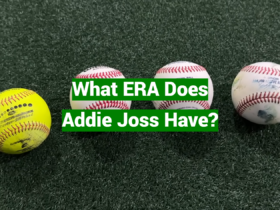Pitching is the backbone of baseball. A team’s success often hinges on having a reliable pitching staff that can shut down opposing offenses. This makes evaluating pitcher performance a crucial task for fans, analysts, and team executives alike.
Among the many statistics used to measure pitchers, none holds as much weight as ERA, or Earned Run Average. ERA distills a pitcher’s effectiveness into a single number that represents the average number of earned runs they allow per nine innings pitched. Unlike opaque newer metrics like FIP and xFIP, ERA is simple to understand but still provides profound insight.
For both diehard statheads and casual fans, a solid grasp of ERA is an essential part of appreciating the craft of pitching. It enables you to compare hurlers past and present, determine an ace from a journeyman, and deeply understand the game within the game between pitcher and batter.
Table of Contents
Unpacking the Mystery: What Exactly is an Earned Run?
At its core, ERA measures a pitcher’s ability to prevent earned runs. But what is an earned run?
Simply put, an earned run is any run that scores without the contribution of a fielding error or a passed ball. If a pitcher allows hits, walks, or hit batsmen that directly lead to runs crossing the plate, those are earned runs.

The table below summarizes the scoring distinction between earned and unearned runs:
| Scoring Play | Run Counts As |
|---|---|
| Single, double, home run | Earned |
| Walk, hit batsman | Earned |
| Error, passed ball | Unearned |
| Sacrifice fly | Unearned |
Only runs directly driven in by a pitcher’s actions count against their ERA. This isolates their performance from the rest of the team’s defense.
The Math Behind the Magic: Calculating ERA
Now that we understand earned runs, let’s walk through the simple formula for calculating ERA:
ERA = (Earned Runs Allowed x 9) / Innings Pitched
You can use our free online ERA Calculator to calculate your ERA score faster.
The earned runs allowed are simply the pitcher’s runs yielded that were not aided by errors or passed balls. The number of innings pitched includes both complete and partial innings.
The key step is multiplying the earned runs by 9. This controls for the length of a full 9-inning game and creates an average number of earned runs per inning pitched. Without multiplying by 9, the statistic would be less meaningful for comparison.

For example, suppose a pitcher allowed 3 earned runs over 6 complete innings pitched. The ERA would be:
- Earned Runs Allowed: 3
- Innings Pitched: 6
- Calculation: (3 ER x 9) / 6 IP = 4.50
So the pitcher’s ERA over those 6 innings is 4.50. This means they allowed an average of 4.5 earned runs for every 9 hypothetical innings pitched. The more innings a pitcher accrues, the more stable their ERA becomes as a measure of performance.
Decoding the Numbers: What Does a Good ERA Look Like?
ERA is one of the few baseball statistics that carries an intuitive scale. While metrics like OPS+ and WAR require interpretation, ERA has some natural reference points:
- Good: Below 3.00
- Average: 3.00 to 4.50
- Poor: Above 5.00
Naturally, many factors influence a pitcher’s ERA within these ranges. Playing home games in a hitter’s park like Coors Field typically inflates ERA relative to a pitcher’s haven like Oracle Park. The quality of a pitcher’s defense also shapes ERA to some degree.
Additionally, the run-scoring environment of each era must be considered when judging ERAs. A 3.50 ERA was excellent in 1968 but merely average during the high-octane scoring of the late 1990s. The table below compares elite ERA performances across eras:
| Player | Year | ERA | Notes |
|---|---|---|---|
| Bob Gibson | 1968 | 1.12 | MLB record low in “Year of the Pitcher” |
| Pedro Martinez | 2000 | 1.74 | Led MLB in peak “steroid era” |
| Jacob deGrom | 2022 | 1.08* | Best of modern MLB with lively baseballs |
While the exact benchmarks may shift, an elite ERA will always hover below 2.00. Only the most dominant pitchers can suppress scoring enough to reach such rarefied air.
Beyond the Numbers: The Nuances of ERA Interpretation
ERA excels as an descriptive statistic – it summarizes how many earned runs a pitcher surrendered. However, it comes with limitations as an evaluative metric of overall pitching quality.
For one, ERA only accounts for runs allowed, not how well pitchers avoid baserunners and dangerous situations. A pitcher with a high WHIP (walks plus hits per innings pitched) but low ERA may be playing with fire and due for regression.
Additionally, factors out of a pitcher’s control like defense and ballpark can cloud ERA. Advanced metrics like FIP (Fielding Independent Pitching) and WAR (Wins Above Replacement) aim to isolate a pitcher’s performance from context and estimate their true skill level.
When interpreting a puzzling ERA, it helps to dig deeper. Has the pitcher been unusually lucky or unlucky on balls in play? Do they strand inherited runners at an unusually high or low rate? While ERA summarizes the end result, underlying trends offer insight into its sustainability.
ERA in Action: Tracking the Greats and the Grinders
Ever since Hall of Famer Mordecai “Three Finger” Brown posted a 1.04 ERA in 1906, pitchers have chased the dream of a sub-1.00 ERA season. The legends who have come closest reveal ERA’s ability to etch greatness in stone.
In the “Year of the Pitcher” 1968, St. Louis Cardinals ace Bob Gibson set the modern MLB record with a 1.12 ERA. His stunning consistency was punctuated by a 47 inning scoreless streak. Decades later, Pedro Martinez seemed poised to break Gibson’s record with a 1.74 ERA for the 2000 Boston Red Sox. Along the way, Pedro turned in one of the greatest pitching seasons ever with an astounding 291 ERA+.
While ERAs below 1.50 remain rare, today’s game still produces its share of elite seasons. Mets ace Jacob deGrom has won back-to-back NL Cy Young awards on the strength of ERAs under 2.00. Before injury struck in 2022, he was on pace to surpass Gibson’s record with a surreal 1.08 ERA.
Even beyond MLB, ERA connects fans across leagues like the Japanese NPB. There, softbank Hawks righty Kodai Senga boasts a career 2.59 ERA while employing his devastating forkball. Wherever professional baseball is played, ERA fuels hurlers’ pursuit of excellence.
Tools for the Trade: Resources for Deepening Your ERA Knowledge
Diving deeper into baseball statistics has never been easier for fans. Resources like FanGraphs, Baseball Reference, and Baseball Savant contain that bring ERA and pitching advanced metrics to life.
For getting started, apps like ESPN’s Baseball Tonight provide an excellent ERA primer and leaderboards. Then for hardcore analysts, sabr metric sites like Baseball Prospectus allow slicing and dicing individual ERA components in granular detail.
Frequently Asked Questions about ERA
What exactly is ERA in baseball?
ERA stands for Earned Run Average. It represents the average number of earned runs allowed by a pitcher per 9 innings pitched. Lower ERAs are better, as they indicate fewer runs allowed.
How is ERA calculated?
The formula is: (Earned Runs Allowed x 9) / Innings Pitched. The earned runs allowed are runs given up by the pitcher that were not aided by errors or passed balls. The number of innings pitched includes both complete and partial innings.
What is considered a good ERA?
Though the exact benchmarks vary by era, generally an ERA below 3.00 is very good, between 3.00 and 4.50 is average, and over 5.00 is poor. The leading pitchers typically have ERAs in the 2.00-3.00 range.
What factors can influence a pitcher’s ERA?
The pitcher’s home ballpark, quality of defense behind them, luck on batted balls, and the run-scoring environment of their era can all significantly impact ERA. Advanced metrics like FIP attempt to isolate the pitcher’s performance.
How should I interpret an unexpectedly high or low ERA?
Look at indicators like BABIP (batting average on balls in play) to check for luck, and metrics like WHIP and walk rate to evaluate if the ERA aligns with their overall performance. Also consider the bullpen’s impact on stranding inherited runners.
Is ERA as useful for relievers as starters?
ERA can be less reliable for relievers because of small sample sizes in innings pitched. Stats like holds, saves percentage, and inherited runner strand rate better evaluate reliever performance.
What are some all-time great ERAs?
Bob Gibson posted a record 1.12 ERA in 1968, while Pedro Martinez registered 1.74 in 2000 during MLB’s high-scoring steroid era. In 2022, Mets ace Jacob deGrom had a 1.08 ERA before injury cut his season short.
How can I learn more about ERA and pitching stats?
Use sites like FanGraphs, Baseball Reference, and Baseball Savant to dive deeper into ERA components and advanced pitching metrics. Also, follow leading analysts on Baseball Prospectus and subscribe to blogs and podcasts focusing on statistical analysis.
Conclusion: Unleashing the Power of ERA – From Fan to Ace
Like being able to read a box score, understanding ERA is an essential baseball fan skill. As you build intuition for what constitutes a good, bad, or average ERA, you’ll find yourself gaining a whole new appreciation for the craft of pitching.
Use ERA as your entry point into the wider world of baseball statistics. Discover new metrics that build on ERA’s foundation and capture different aspects of performance. Most importantly, allow ERA to deepen your connection with the game by bringing legendary hurlers to life.
Every elite pitcher, whether a power pitcher or finesse specialist, has chased that elusive sub-2.00 ERA. Seeing who can defy the odds and reach such rarefied air makes for unforgettable baseball theater. By unlocking ERA, you hold the key to an amazing data story over a century in the making.






Leave a Reply